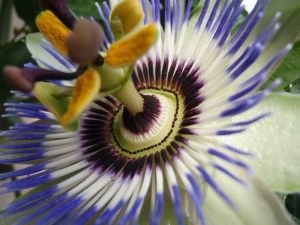Plant parts are divided into vegetative parts and sexual reproductive parts. The sexual reproductive parts are involved in seed production, and include the fruits and the flowers. The vegetative parts aren’t directly involved in reproduction. This includes stems, leaves and roots. Most plants share the same basic parts that have the same fundamental functions.
Roots
Roots provide support for the stems, anchor the plant into the soil and absorb the water and nutrients necessary for the plant’s survival. Roots are typically located below the ground and don’t have any leaves, shoots or nodes. Tiny root hairs increase the root’s surface area so it can absorb more water. Plants have one of two major types of root systems. Some plants, such as carrots and dandelions, have a taproot system that consists of one main root and few side-branching roots. Other plants, such as marigolds and most grasses, have fibrous root systems, which consist of many branched roots. Both types of root systems store the carbohydrates and sugar that plants use to carry out their other functions.
Stems
Stems are the main trunks of plants. The stems allow plants to grow upright by supporting the leaves, buds, fruit and flowers. They also serve as conduits for carrying sugars, water and minerals throughout the plant. While most plants have above-ground stems, some plants have stems located beneath the soil, such as plants with bulbs, corms, rhizomes and tubers. Stems have nodes, which is where the auxiliary buds develop into flowers or leaves.
Leaves
Leaves are the primary food producers for plants. Leaves are responsible for photosynthesis, which is the process that uses chlorophyll and light to turn carbon dioxide and water into glucose. This sugar is the main food source for most plants. Leaves are also the site of transpiration, which turns carbon dioxide into oxygen. Leaves have a variety of shapes that reflect adaptations to various environments. Most leaves are broad, flat and green in order to maximize photosynthesis. The cuticle forms the protective outer layer that prevents disease pathogens from entering the leaves.
Flowers
Flowers produce the seeds necessary for sexual reproduction. The female flower part is the pollen-capturing pistil. The pistil contains the stigma, style and ovary. The male part of the flower is called the stamen, which contains the filament and the pollen-producing anther. Pollination occurs when pollen is transferred to the stigma from the anther. The pollen then travels down to the ovary where it joins with the egg. The flower attaches to the stem at the sepal, which helps to protect the developing bud. Brightly colored petals contain nectar glands and aromatic substances that attract pollinators such as butterflies, bats and bees.
Fruits
Fruits are the ripened ovaries or groups of ovaries that contain the flowers’ seeds. Once a flower’s ovary has been fertilized, it swells to protect the developing seeds. Fruits are generally classified as aggregate, multiple or simple fruits. Aggregate fruit, such as strawberries and raspberries, come from flowers that have several simple pistils. Simple fruits, such as cherries and apples, develop from just a single ovary. Pineapples and figs are both multiple fruits, which means that each fruit develops from a cluster of independent flowers growing on the same structure.
References
http://ag.arizona.edu/pubs/garden/mg/botany/plantparts.html
http://www.hcs.ohio-state.edu/mgonline/Botany/pla01/00pla01.htm





